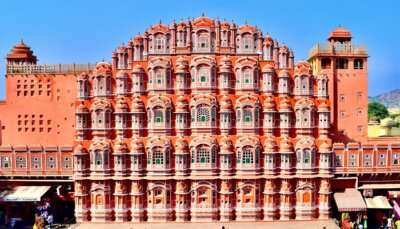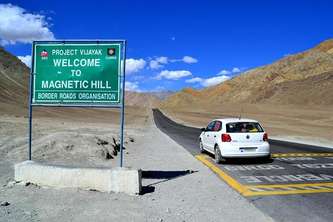Explore The Majestic Begumpur Masjid In 2026 On Your Next Delhi Trip

Situated in the historic city of Delhi, the Begumpur Masjid represents monumental architecture and a rich history pertaining to the Tughlaq era. Firoz Shah Tughlaq built this mosque in the 14th century, and its structure is credited to Prime Minister Khan-i-Jahan Junan Shah. It served as the congregational field of worship for the inhabitants of Jahanpanah, one of the ancient cities of Delhi built by Muhammad bin Tughlaq. This was a great edifice within a larger urban complex and played a significant role in religious and communal life during its flourishing period. The mosque’s establishment exemplifies the Tughlaq dynasty’s vision in their constructions, which were monumental and long-lasting but served spiritual purposes as well, and which would further propagate the impression of their architectural bequest.
About The Begumpur Masjid

Walking through these ruins of the Begumpur Masjid today is like getting an absolutely different view of the past, which really helps in relating to the richness of medieval Delhi inside. The serenity at this site, coupled with the majestic remains, brings about a feeling of greatness and importance that once characterized it. One can easily imagine the echoes of history as one strolls in this expansive courtyard and the ornate prayer hall where hundreds of faithful flock to offer prayers and congregate for daily activities.
The mosque reflects the genius of the Tughlaq dynasty and symbolizes the vast layers that shroud Delhi’s history. This Mosque in Begumpur offers an excellent view of Delhi’s historical and cultural heritage. History lovers and architecture buffs should not miss the experience.
Also Read: Archaeological Museum In Delhi
Architectural Significance And Evolution

The Begumpur Masjid represents one of the finest architectural designs of Tughlaq architecture, which is characteristically robust and austere. The mosque has a large area bounded by high fortified walls, with a big open courtyard. A number of arches and domes over the prayer hall make the interior spacious, airy, and capable of holding big congregations. The design is minimalistic and imposing and has very few decorative elements, instead laying great emphasis on structural solidity and functional design.
Over the centuries, the mosque has suffered periods of neglect, relegating it to partial ruin, but its architectural brilliance still comes through. The site provides useful insights into the advancement in urban planning and architecture during the Tughlaq period and still remains a very important monument in Delhi’s historical landscape.
Historical Background of Begumpur Masjid

Begumpur Masjid in Delhi’s Begumpur area is a 14th-century architectural marvel. This grand mosque was built during the reign of Firoz Shah Tughlaq, the third ruler of the Tughlaq dynasty. According to the resources, it was designed by Khan-i-Jahan Junan Shah, who became prime minister under Firoz Shah. Begumpur Masjid formed part of a much larger urban complex. It was, hence, an important place of worship amongst the residents of Jahanpanah, one of the four medieval cities of Delhi, erected by Muhammad bin Tughlaq. This establishment depicted the zeal of the Tughlaq dynasty for building monumental and permanent robust edifices that could be worthily used for religious and communal functions.
The Begumpur Masjid is the epitome of the Tughlaq dynasty’s penchant for structures that are at once austere and imposing. The huge area that the mosque covers is surrounded by high walls with a minimum of ornamentation, thereby evoking a very Tughlaq architectural ethos. The central prayer hall, supported by numerous arches and domes, has a spacious and airy interior. In the mosque’s plan, there is a huge open courtyard that was used for congregational prayers. Though it is now in partial ruin, the Begumpur Masjid stands as a major monument and gives an impression of the urbanism and architectural development during the Tughlaq period.
Related Post: Agrasen Ki Baoli
The Origins Of Begumpur Masjid

Begumpur Masjid is a historic mosque in the locality of Begumpur, Delhi, dating back to the 14th century. This mosque was constructed during the reign of Firoz Shah Tughlaq and is attributed to Khan-i-Jahan Junan Shah, his prime minister. The mosque was part of a larger urban settlement and was important for worship and community gathering. The construction is inspired by the style of the Tughlaq dynasty, whose trademarks were strong and simple designs that play on functionality and grandness.
Tip: While you visit the Begumpur Masjid in New Delhi, spare a few minutes to explore the surroundings, which will provide further historical information and context for the mosque’s significance.
Begumpur Mosque Prayer Hall

Begumpur Mosque, situated in the Begumpur village near Malviya Nagar in South Delhi, is a magnificent piece of Tughlaqid architecture from the 14th century. Built during the time of Firoz Shah Tughlaq, it embodied the ultimate style that the dynasty could conceive in its architectural settings, with its austere but imposing design.
The mosque covers a vast area, and all around it are high and solid walls with barely any ornamentation—again, a Tughlaq feature that tells of gigantism without much ornamentation. The hall for prayer in the centre and its support of numerous arches and numerous domes preaches a qualitative space and airiness in which light and air freely enter and depart. The mosque’s plan included an open courtyard, a large area, which provided space for congregational prayers for many worshippers. The Begumpur Mosque, though partially ruined at present, is an important historical and architectural monument. It opens up knowledge on urban planning and religious life of the Tughlaq period and shows this dynasty’s commitment to building lasting monuments. However, in all those ravages, the mosque still whispers of grandeur and quietly solemn air, which speaks volumes about the architectural capacity and cultural great tradition left behind by Tughlaq.
You May Also Like To Read: Sanjay Van
Be charmed by the bewitching beauty of Begumpur Masjid and let it transport you into the vortex of time. Be it a history enthusiast, architecture lover, or anybody seeking serenity, Begumpur Masjid offers a riveting experience. Explore these ruins in majesty, marvel over the arches and domes, and feel the whispers of a time gone by. This is your chance to get in touch with Delhi’s rich heritage. Plan your trip to Delhi and be a part of the grandeur of the Tughlaq dynasty!
For our editorial codes of conduct and copyright disclaimer, please click here.
Cover Image Credit: Parth.rkt for Wikimedia Commons
Frequently Asked Questions About Begumpur Masjid
What is the historical importance of Begumpur Masjid?
Begumpur Masjid was built in the 14th century during the reign of Firoz Shah Tughlaq, hence forming a significant monument of the Tughlaq dynasty. It was an important place of worship and a central hub for the inhabitants of Jahanpanah—one of Delhi's ancient cities.
Where is the Begumpur Masjid located in Delhi?
The mosque has a large courtyard, several arches and typical Tughlaq architecture with domes. Its powerful and sombre design gives much importance to the functional aspect of the structure, a fusion between Persian and Indian styles.
What are the special architectural features of Begumpur Masjid?
The mosque has a large courtyard, many arches and typical Tughlaq architecture with domes. Its powerful and somber design gives much importance to the functional aspect of the structure, a fusion between Persian and Indian styles.
How to Reach Begumpur Masjid?
One can easily reach Begumpur Masjid by bus, auto-rickshaw, or taxi. The metro station is Hauz Khas, which is on the Yellow Line. One may avail a cab or auto-rickshaw from there to reach this site.
Are there any fees for entry to the Begumpur Masjid, and what are the hours of visitation?
No entrance fee is charged for visiting the Begumpur Masjid at present. It remains open to visitors from sunrise until sunset. However, do check any changes in timings or entry policies before visiting.
People Also Read:
Toli Masjid Thazhathangady Juma Masjid Jumma Masjid Bijapur











